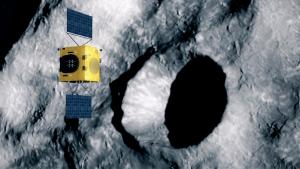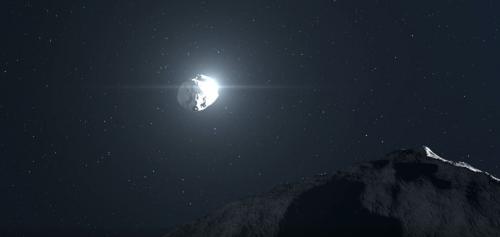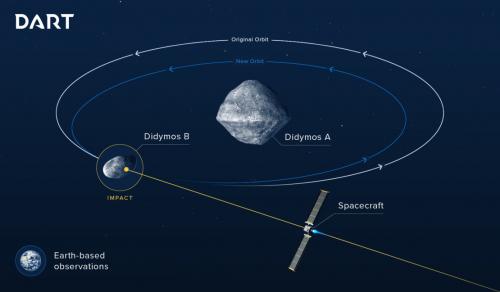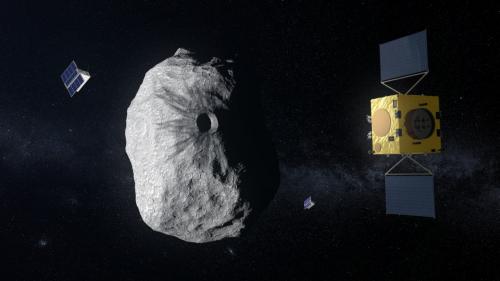Europe and US teaming up for asteroid deflection
Asteroid researchers and spacecraft engineers from the US, Europe and around the world will gather in Rome next week to discuss the latest progress in their common goal: an ambitious double-spacecraft mission to deflect an asteroid in space, to prove the technique as a viable method of planetary defence.

Hera at Didymos.
This combined mission is known as the Asteroid Impact Deflection Assessment, or AIDA for short. Its purpose is to deflect the orbit of the smaller body of the double Didymos asteroids between Earth and Mars through an impact by one spacecraft. Then a second spacecraft will survey the crash site and gather the maximum possible data on the effect of this collision.

DART impacting asteroid
The three-day International AIDA Workshop will take place on 11–13 September in the historic surroundings of the ‘Aula Ottagona’ in central Rome, part of the Baths of Emperor Diocletian which went on to serve as a planetarium in the last century.

‘Aula Ottagona’
Participants will share the current progress of the two spacecraft making up AIDA – including the smaller nano-spacecraft they will carry aboard them – as well the latest results of global astronomical campaigns undertaken to learn more about the distant Didymos asteroids.

DART impact
NASA’s contribution to AIDA, the Double Asteroid Impact Test, or DART spacecraft, is already under construction for launch in summer 2021, to collide with its target at 6.6 km/s in September 2022. Flying along with DART will be an Italian-made miniature CubeSat called LICIACube (Light Italian CubeSat for Imaging of Asteroids) to record the moment of impact.

Hera at Didymos
Then will come ESA’s part of AIDA, a mission called Hera which will perform a close-up survey of the post-impact asteroid, acquiring measurements such as the asteroid’s mass and detailed crater shape. Hera will also deploy a pair of CubeSats for close-up asteroid surveys and the very first radar probe of an asteroid.
The results returned by Hera would allow researchers to better model the efficiency of the collision, to turn this grand-scale experiment into a technique which could be repeated as needed in the event of a real threat.
Hera is currently undergoing final phase B2 design work, ahead of a decision to proceed by Europe’s space ministers at the Space19+ Ministerial Conference this November, as part of the proposed new ESA Space Safety Programme. Launch will occur in October 2024 and the journey will take about two years.
“DART can perform its mission without Hera – the effect of its impact on the asteroid’s orbit will be measurable using Earth ground-based observatories alone,” explains Ian Carnelli, managing Hera for ESA.
“But flying the two missions together will greatly magnify their overall knowledge return. Hera will in fact gather essential data to turn this one-off experiment into an asteroid deflection technique applicable to other asteroids. Hera will also be the first mission to rendezvous with a binary asteroid system, a mysterious class of object believed to make up around 15% of all known asteroids.
“And our mission will test a variety of important new technologies, including deep space CubeSats, inter-satellite links and autonomous image-based navigation techniques, while also providing us with valuable experience of low-gravity operations.
“I also believe it is vital that Europe plays a leading role in AIDA, an innovative mission originally developed through ESA research back in 2003. An international effort is the appropriate way forward – planetary defence is in everyone’s interest.”
A near-Earth asteroid system, Didymos’s main body measures about 780 m across, with its moonlet about 160 m in diameter, about the size of Egypt’s Great Pyramid. It was selected carefully as a deflection target.
Due to the relatively small mass and gravities of these bodies, the smaller asteroid orbits its parent at a comparatively low velocity of a few centimetres per second, making it feasible to shift its orbit in a measurable way – something which would not be achievable so precisely with a lone asteroid in a much more rapidly moving solar orbit.
Source: European Space Agency
- 215 reads
Human Rights
Ringing FOWPAL’s Peace Bell for the World:Nobel Peace Prize Laureates’ Visions and Actions

Protecting the World’s Cultural Diversity for a Sustainable Future

The Peace Bell Resonates at the 27th Eurasian Economic Summit

Declaration of World Day of the Power of Hope Endorsed by People in 158 Nations

Puppet Show I International Friendship Day 2020

